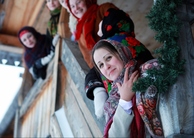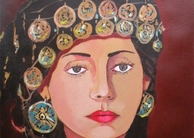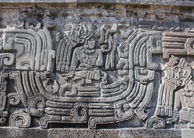Discussing Refugee Women: Speechlessness, Helplessness and Bodies-as-Facts
By
2015, Vol. 7 No. 08 | pg. 1/2 | »
IN THIS ARTICLE
KEYWORDS
“Not all silences are equal,” writes Michel-Rolph Trouillot (1997, p.27). Not everyone, I add, possesses the power to silence a person or a group of people. In this research paper, I use gender as an analytical tool to examine the way refugee women are silenced through the transformation of their bodies into facts, which as a result turns them into the most helpless and speechless of all refugees. In the first part of this essay, I give an overview of the creation of the Convention relating to the status of Refugees, adopted in 1951. I briefly comment on how it has been introduced as a male paradigm without a gender perspective. I then examine the later recognition of women in the Refugee Convention and problematise the attempts made at integrating women into pre-existing institutions and discourses about refugees. The second part of my research looks at the different processes that led to the construction of refugees as victims. I look at the essentialisation of the bodies of refugees and the resulting portrayal of refugees as speechless and helpless victims. In the third section of the paper, I address the efforts made toward conceptualizing refugees as gendered bodies. In order to do so, I address the essentialisation and victimization of women which, as a consequence, turns them into the most "helpless" of all refugees. In the fourth and final section of the paper, I explain how and why women’s bodies are given the meaning of fact-bearers where suffering can be located. Finally, I link the processes of turning bodies into facts with the silencing of refugees.The 1951 Refugee Convention, Women, and Structural InequalitiesIn order to understand the creation and the formation of "refugee" as a category, it is important to discuss the creation of the Refugee Convention of 1951. The Convention is considered one of the cornerstones of the refugee regime and has greatly shaped policies regarding the treatment of refugees and displaced persons. In Gender and the Evolving Refugee Regime, Martin (2010, p.107) provides a brief overview of the history of the refugee regime. She writes that the refugee category – or at least the way we know it today – is an invention of the 20th century. It was elaborated in order to address the issues of displacement caused by a series or wars, including the two World Wars of course, and mass movements of population caused by the Russian Revolution and the collapse of the Ottoman and Hapsburg Empires (Martin 2010, p.107). It was in 1921 that the first High Commission of Refugee was instituted by the League of Nations (Martin 2010, p.107). Deeply affected by the second World War and the rising number of refugees fleeing Nazi persecution, a number of other organizations were set up to answer the problem of refugees and displaced persons in Europe (Martin 2010, p.108). In the aftermath of the adoption of the Universal Declaration of Human Rights in 1948, States were to address the issue of the millions of persons who remained displaced (Martin 2010, p.108). It led to the adoption, in 1951, of the Convention relating to the status of Refugees. It should be noted that during the drafting of the Convention, the States and actors involved were mostly concerned with the issue of refugees and displaced persons in Europe which resulted from the political turmoil of the 20th century (Martin 2010, p.109). The Refugee Convention was thus heavily influenced by the European political context; it was only in 1967, with the adoption of the Protocol Relating to the Status of Refugees, that those geographical and temporal limitations were lifted and turned the Refugee Convention into a universal document to be applied to refugees worldwide. Women, as it turned out, were completely left out of the Convention. Doreen Indra (1987, p.3), in an article written three years before the adoption of the UNHCR Policy on Refugee Women, emphasizes that from the outset, discourses and researches about refugees have primarily posited the question of refugees as a male paradigm. The Convention relating to the Status of Refugees of 1951 clearly illustrates the gender bias of the document: it defines a refugee as a person with a "well-founded fear of being persecuted for reasons of race, religion, nationality, membership of a particular social group or political opinion, is outside the country of his nationality and is unable [...] to avail himself of the protection of that country [...]" (emphasis added). The whole Convention goes on that way. As Indra (1987, p.3) stresses, it is indeed surprising to notice that gender oppression and violence are not once considered or mentioned as possible forms of persecution throughout the document. Moreover, she rightfully notes that "many women around the world could be unambiguously considered refugees on the basis of sex and gender oppression without doing violence to the spirit of the [...] Convention" (Indra 1987, p.3). Indra argues that one of the major problems with the creation of the refugee category is that it came to label people as refugees first, and men and women second; now is time, she offers, that we consider them as "men and women who happen to be refugees" (Indra 1987, p.4). Rapes, assaults, gender violence and other forms of sexual violence are all tactics used in places of conflict that force, provoke, or contribute to displacements. Interestingly, conflicts are commonly understood to be violent, yet women's bodies have often been neglected as a territory where violence can be conducted (Baine 2004, p.2). In 1990 was adopted the UNHCR Policy on Refugee Women and in 1991 the Guidelines on the Protection of Refugee Women. The Guidelines finally recognized that refugee women could be persecuted on grounds of their gender and sex (Martin 2010, p.115). It was during the mid-decade meeting of the Decade for Women: Equality, Development, and Peace in 1980 that specific resolutions aimed at refugee women were discussed (Martin 2010, p.113). However few of the recommendations discussed were implemented in the following years; it was only toward the end of the Decade for Women that UNHCR organized a Roundtable to address more specifically the issue of refugee women. It was in the five years following the Roundtable that policies regarding the status of refugees were reoriented and evaluated with a gendered perspective. In WID, WAD, GAD: Trends in Research and Practice, Rathgeber (1990 p.496) reaches the general conclusion that few development agencies have challenged the very structures through which, and within which, fundamental inequities and certain ideas about gender are perpetuated. The efforts made towards readjusting policies concerning refugees to include women thus appear to be a textbook example illustrating the different trends devised to include women in development projects. Rather than questioning the very reasons why women had been left out of the Refugee Convention in the first place, or how the document perpetuated a certain form of discrimination towards women, the focus was given on how to best integrate women in already existing structure (Rathgeber 1990, p.491). Using gender as an analytical tool, then, becomes powerful because it forces one to consider relationships of power on a large spectrum; it forces one to look at the role of international agencies in perpetuating inequalities between men and women, working with a structure that participates in the production of problematic policies. Speechlessness, Helplessness, and CorporealityIn this part, I wish to engage with the different processes that led to the construction of refugees as victims. Speechlessness and helplessness both have very unique relationships with - and are intrinsically linked with - the bodies of refugees. As previously discussed, the definition of a refugee is a person with a "well-founded fear of being persecuted [...] outside the country of his nationality and is unable [...] to avail himself of the protection of that country [...]" (Refugee Convention 1951). This definition of a refugee implies that every individual belongs to a state, and that the state's role is to act as a channel through which individuals can be represented (Rajaram 2002, p.251). Individuals without a state, or dispossessed of one, are considered speechless, meaning that they no longer can rely on their political identity, and its links with a specific form of government and territory, "to signify, to negate, to initiate its historic desire" (Werbner 2001, p.133 in Rajaram 2002, p.251). Refugees, as a consequence, are individuals whose voices can no longer be heard. Turned into speechless actors, they therefore need someone to speak for them; they require representation from an established agency whose role is to voice and represent tem (Rajaram 2002, p.251). As a consequence of their voicelessness, all that speechless refugees are left with is their biological corporeality (Rajaram 2002, p.252). The identity of refugees is thus essentialised in very peculiar ways: in this case they are reduced to their bodies (Rajaram 2002, p.262). If speechlessness is somehow related to the bodies of refugees, so is helplessness. Malkki, in her article Speechless Emissaries: Refugees, Humanitarianism, and Dehistoricization, is interested with the category of "refugee" as a dimension of collective identity. Basing her observations on fieldwork conducted among Hutu refugees in Tanzania, she contrasts the refugee's vision of what it means for them to be a refugee, versus the administrator's definition of the same term. She argues that the Hutus have come to appropriate the category as a historicizing dimension of their collective identity (Malkki 1996, p.377). She however highlights that this appropriation clashed with the administrators' vision of what constitutes a refugee. Their definition, Malkki (1996, p.84) argues, is closely linked with a certain image of helplessness. In her article, she writes that over time, Hutu refugees have organized their economic practices, and some of them have even become "merchant refugees" through continuing participation in trade. "A rich refugee", she notes, was seen as a "contradictory term" (Malkki 1996, p.382). The idea that refugees can have a certain material comfort, or become more prosperous than the local population through economic activities, challenged the definition the administrators had of what constitutes a refugee. In short, the refugees' status was disputed on grounds of material well-being (Malkki 1996, p.383). That refugees should be devoid of economic or material well-being, I argue, is one key feature of their helplessness. Based on that example, Malkki (1996, p.348) suggests that helplessness is something that is looked for in a refugee's physical appearance. As one member of the Tanganyika Christian Refugee Service (TCRS) told Malkki, the problem was with the way Hutu refugees in Tanzania looked like: "I should show you a film [...] of the Burundi refugees when they first came. One was showing a bullet wound, someone else a cut [...] They had nothing [...] These people don't look like refugees anymore" (Malkki 1996, p.384). Malkki (1996, p.384) sees in this ideal image of the refugee an attempt to "fix the "real" refugee on extralegal grounds". The identification of the real refugees, her article suggests, can be possible if one can see the proofs of helplessness on one's body. Refugees as Gendered BodiesIn this section of my paper, I wish to explore the processes which turn refugee women into the most "helpless" of all refugees. In order to do so, I have to address first the gender and culture essentialisation of women and their ensuing victimisation. In the 1980s and 1990s, an increasing focus on violence against women over time has been given at the international level (Kapur 2002, p.2). In her article The Tragedy of Victimization Rhetoric, Kapur notes that overall, this attention had been beneficial to women. It directed attention towards lacks and gaps in governments, institutions and laws regarding women (Kapur 2002, p.2). As I have explained, during the same time, a similar attention was given to refugee women which led to the adoption of the Policy on Refugee Women. Kapur (2002, p.3) underlines that the "violence against women" discourse has been successful, however, because it managed to construct women as victim subjects. This specific articulation of the victim subject, she argues, is based on gender essentialism (Kapur 2002, p.3). In other words, the "violence against women" narrative created women as a coherent group facing the same issues; it relied on the universality of women as victim subjects (Kapur 2002, p.3). Many scholars and feminists criticized this gender essentialist discourse, which led to arguments in favour of the inclusion of cultural differences when addressing violence against women (Kapur 2002, p.5). Unfortunately, the efforts to consider differences among women based on their context and cultural backgrounds have paved the way to cultural essentialism. According to Kapur (2002, p.3), the focus on women as victims of violence was reinforced by cultural essentialism. She writes that "women in the Third World are portrayed as victims of their culture, which reinforces stereotyped and racist representations of that culture" (Kapur 2002, p.3). At the end of the day, it leads to the representation of women in the Third World as the most marginalised of all victims, being as they are represented as both victims because of their gender, and victims of their cultures. The representation of refugee women as the most helpless of all refugees is closely linked to gender and culture essentialisation. Malkki (1996, p.388) identifies women and children as a typical conventional representation of refugees. Although the topic of this paper is not specifically about visual representations of refugee women, some examples of representations provided by Malkki are useful in shedding light on the way gender essentialisation is used to turn women into helpless refugees. In Speechless Emissaries, Malkki (1996, p.386) suggests that representations of refugees that emerged after the Second World War and the creation and deployment of humanitarian policies made their way into the media. Malkki identifies visual representations as striking examples where helplessness is most tied with gender essentialisation (Malkki 1995, p.9-10). She gives as an example a wall calendar made by the UNHCR that was titled Refugee Women. All the pictures in the calendar depicted women using either close-up portraits, shots of women and children, or women engaging in reproductive unpaid labour such as sewing, cooking, caring for others, etc. (Malkki 1995, p.10). She agrees to say that these gendered representation of refugee women can be caused by multiple reasons, but ultimately singles one reason out. She argues that the representing women and children in these ways serves to exhibit a special kind of powerlessness. This powerlessness, I want to suggest, is tightly linked to gender and culture essentialism. As I have mentioned earlier, women have been construed as a universal category with privileged claims as victims subjects. When this universal category of womanhood is challenged based on cultural differences, Third World women become victims of their cultures as well. Added to this portrayal of women are, as I have demonstrated earlier, the helplessness and speechlessness associated with refugees. None of the pictures of the calendar had any caption. None of the pictures portrayed women in empowering positions. They were represented with the bare humanity refugees are too often associated with (Malkki 1996, p.390).Continued on Next Page » Suggested Reading from Inquiries Journal
Inquiries Journal provides undergraduate and graduate students around the world a platform for the wide dissemination of academic work over a range of core disciplines. Representing the work of students from hundreds of institutions around the globe, Inquiries Journal's large database of academic articles is completely free. Learn more | Blog | Submit Latest in Anthropology |


















